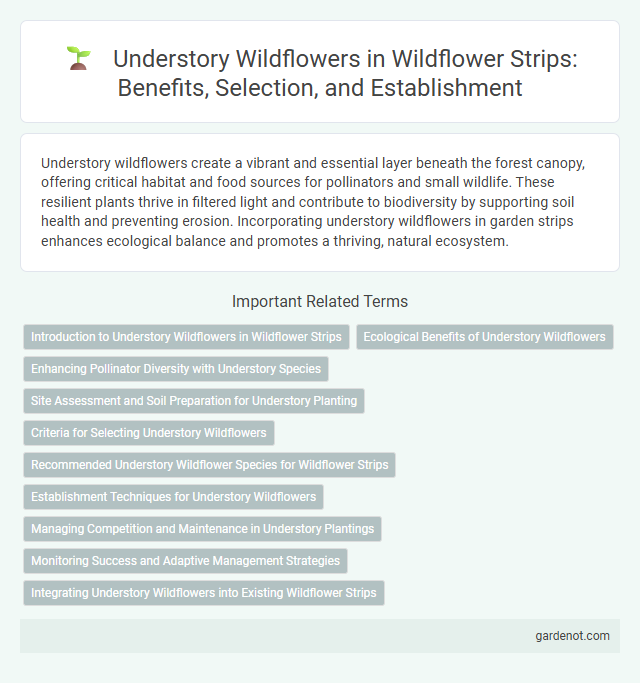Understory wildflowers create a vibrant and essential layer beneath the forest canopy, offering critical habitat and food sources for pollinators and small wildlife. These resilient plants thrive in filtered light and contribute to biodiversity by supporting soil health and preventing erosion. Incorporating understory wildflowers in garden strips enhances ecological balance and promotes a thriving, natural ecosystem.
Introduction to Understory Wildflowers in Wildflower Strips
Understory wildflowers play a crucial role in wildflower strips by enhancing biodiversity and providing essential habitat for pollinators and beneficial insects. These shade-tolerant plants thrive beneath taller vegetation, increasing structural diversity and improving soil health through nutrient cycling. Incorporating understory wildflowers in wildflower strips promotes ecosystem resilience and supports sustainable landscaping practices.
Ecological Benefits of Understory Wildflowers
Understory wildflowers enhance biodiversity by providing critical habitat and food sources for pollinators such as bees and butterflies, which support ecosystem stability. These plants improve soil health through nutrient cycling and erosion control, promoting a balanced microhabitat for fungi and microorganisms. Their presence also aids in water retention and moderates microclimates, contributing to the resilience of forest ecosystems.
Enhancing Pollinator Diversity with Understory Species
Understory wildflower species such as Trillium, Bloodroot, and Virginia Bluebells play a crucial role in enhancing pollinator diversity by providing early-season nectar and pollen resources. These shade-tolerant plants support a wide range of native bees, butterflies, and other pollinators during critical periods when canopy flowers are scarce. Incorporating diverse understory wildflowers into wildflower strips increases habitat complexity and ensures continuous floral resources, boosting overall ecosystem health and pollination services.
Site Assessment and Soil Preparation for Understory Planting
Conduct a thorough site assessment to evaluate light availability, soil texture, pH, and drainage conditions for successful understory wildflower planting. Test soil nutrient levels and organic matter content to guide amendments, ensuring a well-drained, acidic to neutral pH environment typical of forest understories. Prepare the soil by removing competing vegetation, lightly tilling or raking to create a fine seedbed, and incorporating organic compost to enhance moisture retention and fertility.
Criteria for Selecting Understory Wildflowers
Selecting understory wildflowers requires consideration of shade tolerance, as these plants thrive beneath canopy trees with filtered light. Soil moisture and type are critical factors, with many understory wildflowers favoring well-drained, humus-rich soils. Native species adapted to local ecosystems support biodiversity and provide essential habitat for pollinators and wildlife in shaded garden areas.
Recommended Understory Wildflower Species for Wildflower Strips
Recommended understory wildflower species for wildflower strips include Echinacea purpurea, Asclepias tuberosa, and Rudbeckia hirta, all known for their vibrant blooms and pollinator support. These species thrive in partial shade beneath taller plants, enhancing biodiversity and providing essential habitat for bees and butterflies. Incorporating such native wildflowers promotes soil health, improves ecological resilience, and increases the aesthetic value of wildflower strips.
Establishment Techniques for Understory Wildflowers
Establishment techniques for understory wildflowers include selecting native species adapted to shade and moist soil conditions, preparing the site by removing invasive vegetation, and using methods such as direct seeding or transplanting plug plants to promote growth. Timing is critical, with early spring or fall planting ensuring optimal soil moisture and temperature for seed germination. Incorporating mulch and maintaining consistent moisture enhances seedling survival and accelerates the development of a diverse wildflower strip beneath tree canopies.
Managing Competition and Maintenance in Understory Plantings
Managing competition in understory wildflower strips requires regular assessment of light availability and soil nutrients to ensure optimal growth conditions. Maintenance practices such as selective weeding and mulching reduce invasive species and enhance moisture retention, promoting biodiversity. Monitoring growth patterns and adjusting pruning schedules prevent overshadowing by taller plants, sustaining healthy understory development.
Monitoring Success and Adaptive Management Strategies
Monitoring success in understory wildflower strips involves regular assessment of plant diversity, growth rates, and pollinator activity to ensure ecological balance and habitat health. Adaptive management strategies include adjusting planting techniques, controlling invasive species, and modifying irrigation based on monitoring data to optimize wildflower establishment and resilience. These practices enhance biodiversity, support pollinator populations, and promote sustainable ecosystem services in forest understories.
Integrating Understory Wildflowers into Existing Wildflower Strips
Integrating understory wildflowers into existing wildflower strips enhances biodiversity by providing habitat and food sources for pollinators and ground-nesting insects. Species such as Trillium, Bloodroot, and Bluebells thrive in shaded conditions beneath taller plants, improving ecological complexity and seasonal interest. Strategic planting of these shade-tolerant wildflowers supports layered vegetation structures, promoting soil health and stabilizing microclimates within the wildflower strip ecosystem.
Understory wildflower Infographic

 gardenot.com
gardenot.com